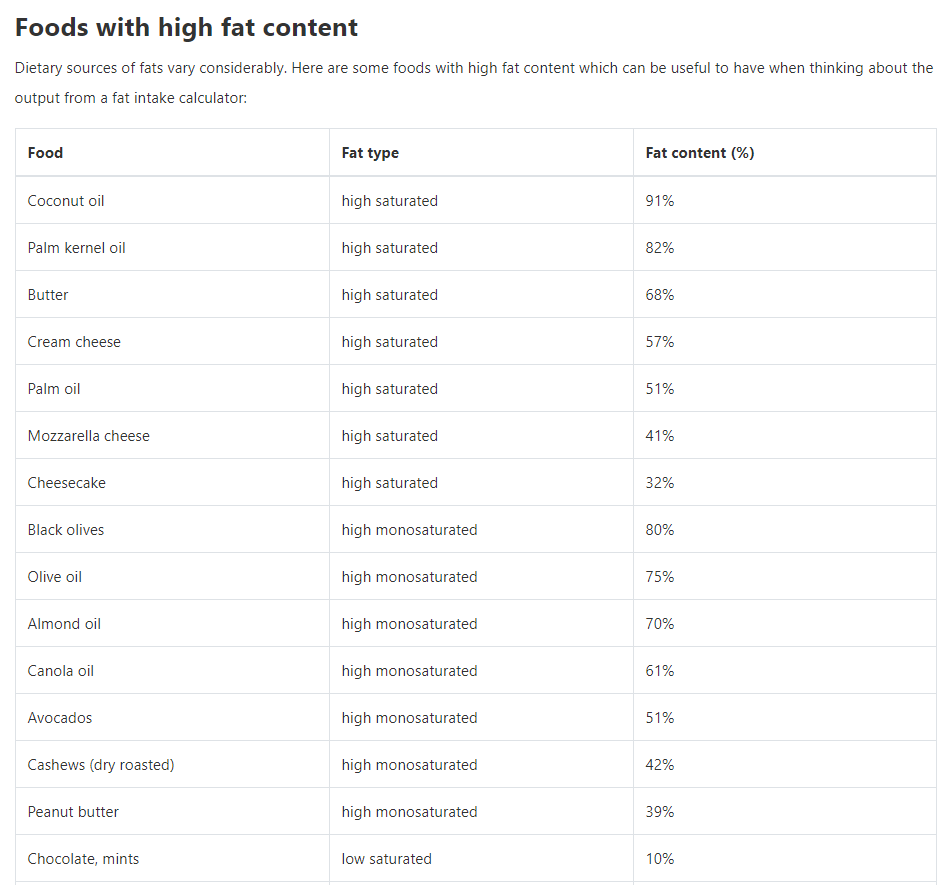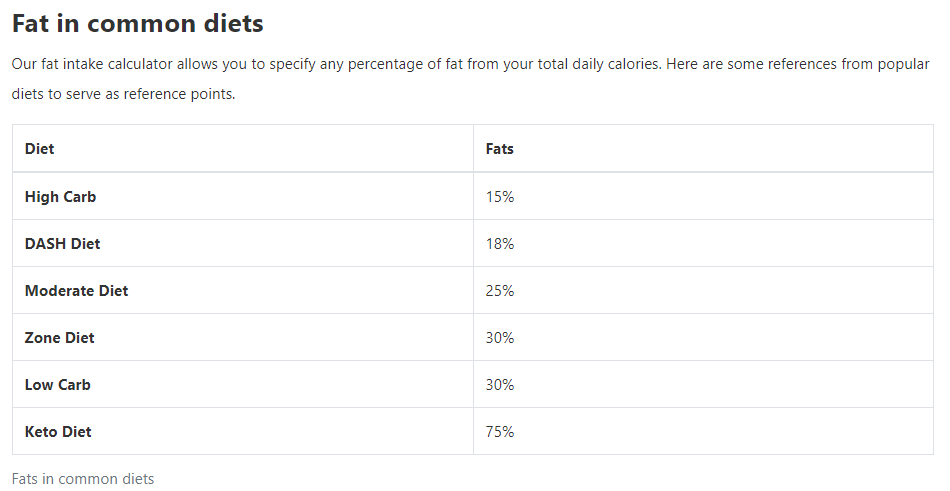Nutrition/Fats Calculator
Body Mass Index (BMI) Calculator, Ideal Body Weight Calculator, Daily Calorie Intake Calculator, Calories Burned Calculator, Calorie Calculator
Fat Intake Calculator?
This fat intake calculator estimates your total daily energy expenditure (TDEE) and based on it calculates how much fat you need to consume in ounces or grams, and their calorie equivalent, depending on your preferred percentage of fats in your total calorie intake.
To calculate your calorie needs, we need to provide your age, gender, height, weight and level of physical activity. The final piece of information needed is the percentage of total calories that you want to derive from fats. For reference, you can check a list of fats in common diets below. The fat intake calculator will display the amount (in ounces or grams) and caloric equivalent of the fats you need to eat per day. You can then structure your daily diet using this information.
What are fats?
In proper medical terms, fats are only a subset of lipids, but in common language the word "fats" is often used instead of "lipids". Lipids are a category of macronutrients consisting of oils, fats and waxes. An easy way to tell one from the other is that oils are liquid at room temperature whereas fats remain solid. Most lipids that we consume come in the form of triacyglycerols. In the diet of the typical American fats from plant sources are about 34% of all, while lipids from animal origin comprise the other 66%.
Fats are further divided into saturated fatty acids and unsaturated fatty acids. Saturated fats are plentiful in beef, lamb, pork, chicken, egg yolk. They are also present in cream, milk, butter and different cheeses. Some plant-based products also include fats, like coconut oil, palm oil, margarine. You can encounter them in most commercially made cakes, pies, cookies, etc. Unsaturated fats are encountered in canola oil, olive oil, peanut oil, almonds, pecans, and avocados. Polysaturated fatty acids are found in safflower, sunflower, soybean, and corn oil. Note that in our fat calories calculator we do not give advice on how to balance the different types of fats (lipids), just an overall estimation.
Lipids (fats) are transported in the blood by lipoproteins, also known as cholesterol. Low-density lipoproteins are known as "bad cholesterol" since it tends to deposit in cells located comprising the arterial wall. You can affect your "bad cholesterol" blood levels through regular exercise, by controlling your visceral fat accumulation and by adjusting your diet composition. High-density lipoprotein, so-called "good cholesterol" acts in the reverse manner - it helps remove cholesterol from cells in the arterial wall. That cholesterol is then transported to the liver, from where it is finally excreted as waste.
Trans-fatty acids are basically the unwanted fat in your body. It is derived as result of the hydrogenation of unsaturated corn, soybean, and sunflower oil. The richest trans-fat sources include margarines, crackers, cookies, snacks, fried foods, dressings, many baked foods. These should be avoided due to health consequences, and the U.S. Food and Drug Administration (FDA), as well as regulators in other countries, have taken measures to reduce the amount of trans-fatty acids in different commercial foods. One of the ill effects of consuming trans-fatty acids is the reduction of beneficial HDL cholesterol in the blood, increasing the risk of heart disease.
Yet, fats are an essential nutrient, so make sure to not calculate for a too low percentage of fat calories. The role of fats in your body is as an energy reserve, as a transport medium for some fat-soluble vitamins. Eating fats also suppresses the hunger reflex. Fats also protect your vital organs and provide thermal insulation, vital in colder conditions.
Fats are also essential to an exercise diet, as they contribute to the energy required during physical exertion. This happens from the fat storage sites and also in the form of free fatty acids (FFA) bound to blood albumin that are delivered to the muscles. Some fats are stored in the muscles themselves. Usually, during the first hour of exercise fats contribute about 50% of the energy, increasing to 70% in the third hour.
Foods with high fat content Dietary sources of fats vary considerably. Here are some foods with high fat content which can be useful to have when thinking about the output from a fat intake calculator:

How much fats do you need? Optimal fat intake
Moderate consumption of fats is recommended to achieve good health. Too high or too low percentage of lipids in the diet have adverse health effects. Most health professionals recommend that fats constitute at most 30% of your diet, of which no less than 70% should be unsaturated fat. Note that our fat intake calculator makes no recommendation on the macro balance of your diet - it simply tells you how many calories you need to eat to maintain weight, increase or decrease it, accordingly.
Several polyunsaturated fatty acids, especially linoleic acid (in cooking oil and salad oil), are an essential nutrient as they are precursors of essential fatty acids (an omega-6 fatty acid that the body itself cannot produce). Fish and different oils are a great source.
In terms of cholesterol, there issue of a recommendation for dietary cholesterol remains controversial. An American Heart Association/American College of Cardiology report concluded there isn’t scientific evidence to show limiting it would reduce the artery-clogging LDL cholesterol in the blood. Others disagree and cite newer evidence that suggest a positive impact from reducing LDL. In previous guidelines, Americans were told to limit dietary cholesterol to 100 mg per 1000 calories consumed, or about 300 mg per day.

Weight loss by reducing fats in the diet
Since the energy requirements of various metabolic pathways make it particularly efficient for the body to convert excess calories from dietary lipids to fat in fat depos, it is recommended to consider limiting the amount of fat consumed when the goal is losing weight. Using the above calculator, you can estimate the required fat intake at different percentages that fat contributes to total daily energy.